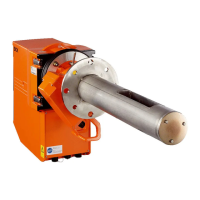72
8009441/YN36/V3-0/2015-08| SICKOPERATING INSTRUCTIONS|GM35
Subject to change without notice
START-UP
7.3.3 Cleaning optical interfaces
▸ Check the optical interfaces of the SR-unit (the front window) and the reflector for soiling
and clean with an optical cleaning cloth when necessary,
see “Cleaning the optical inter-
face (window) on the SR-unit”, page 90
.
7.3.4 Information on fitting the SR-unit and reflector
7.4 Measuring path free from sample gas - zero path
The GM35 must always be adjusted in an atmosphere free from sample gas and dust, i.e.
not when the system is fitted on the duct. The device does however automatically consider
normal ambient humidity. This means a zero path must be prepared. The only exception to
this are newly assembled installation environments that have not been put into operation
yet, whereby it can be ensured that the sample gas duct remains flooded with ambient air
free from sample gas and dust while the work described below is being carried out. In this
case, flanges with tube already installed can be used as brackets on the (currently unused)
sample gas duct during adjustment work. A zero path must be available for subsequent
maintenance work.
7.4.1 Preparing a zero path
The zero path is a copy, free from sample gas, of the measuring path. Whenever possible,
the zero path should be located at the measuring point so that the adjustment can be
carried out on site.
Observe the following when preparing the zero path:
• The exact length of the flange - flange measuring path must be known.
• Make a tube piece with ∅ 200 mm (use several pieces when necessary) with flanges
with exactly the same length as the flange - flange measuring path:
– The interior of new tubes must be painted in matt black; rusty surfaces of older tubes do
not need to be treated.
– Support the pipe against sagging.
– When not in use, seal the tube to ensure that dust cannot enter it.
Note The zero path must have exactly the same length (± 2%) as the flange - flange distance
on the duct plus 446 mm (both purge air fixtures).
Set the gap between device flange and purge air fixture to approx. 5 mm so that the cup
springs have sufficient pre-loading strength.
An additional set of device fixture flanges that remain on the tube is useful when the
tests are made frequently or made for several devices. This means much less assembly
work and one-off alignment.
• Assemble the zero path in the proximity of the SR-unit.
NOTICE: Do not use detergents because their residues, not visible to the naked
eye, will falsify measurement results. If necessary, use distilled water.
NOTICE: SICK recommends installing the SR-unit and the reflector first during
start-up because these must first be adjusted on a zero path.
Installation before start-up is only possible with the purge air supply in
operation.

